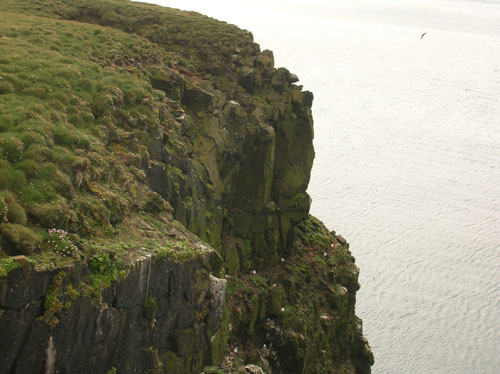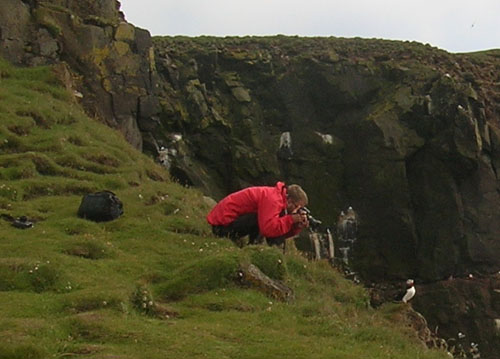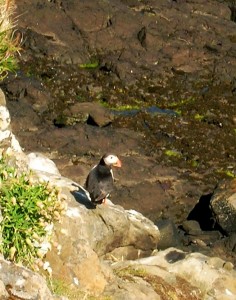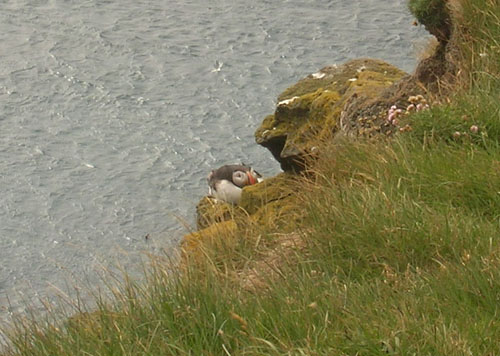There once was a puffin, just the shape of a muffin Posted by hulda on Jul 19, 2012 in Icelandic culture, Icelandic customs
…And he lived on and island in the bright blue sea!
~Florence Page Jaques
Few birds are as iconic to Iceland as lundi, Atlantic puffin. They live in large colonies all around the shorelines of Iceland but especially in the Vestmannaeyjar (= Westman Isles) where the largest puffin colony of the world is located. Often they prefer cliffs but occasionally puffins nest even on rocky slides near the water, like on the island of Flatey (= Flat Island*) in Breiðafjörður (= Wide Fjord).
For most of the year puffins live out on the ocean and only come ashore for the mating season that lasts from May to August, during which time puffin watching tours will be available in almost every single city that’s near a puffin colony. Tours are often on the expensive side, so I suggest that for the best value for your money it’s good to aim for late July or early August: at first the puffins will be shy but over the summer they’ll learn that humans on ships are not a threat, so they’ll let you get a lot closer. Despite having a reputation as a tourist attraction, puffins are an important part of Icelandic wildlife and also very dear to the Icelanders, just because of the way they are**.
 Látrabjarg, another large puffin colony that’s located on the north side of Breiðafjörður. It’s possible to walk all the way to the edge of the cliffs but beware, the grass often grows out over the rocks, and tourists do fall down on an occasion if they wander too far. Bear in mind that even though it carries a puffin it may still not carry a human.
Látrabjarg, another large puffin colony that’s located on the north side of Breiðafjörður. It’s possible to walk all the way to the edge of the cliffs but beware, the grass often grows out over the rocks, and tourists do fall down on an occasion if they wander too far. Bear in mind that even though it carries a puffin it may still not carry a human.
They arrive every May, heralding summer. The males return first to either claim or dig a burrow or a site for it***, where the nest will be built. After a while the females will follow to find their life partner, to mate and to raise a lundapysja (= puffling) together. Atlantic puffins are monogamous and only accept a new mate if the old one dies, which means that if the Mrs is late in returning ashore there may be a new lady in her husband’s burrow… but no worries, the moment the old wife shows up the new one will be thrown out. It may sound a bit cold but such is the life of puffins: the first one they choose they stick with.
At this moment the pufflings are already hatched and are growing in the safety of the burrows. Puffins feed on many types of fish but the pufflings are very dependant on sandeel, which are tiny enough for them to swallow. If sandeels are scarce many pufflings either starve, or it may be that the parental couple doesn’t lay an egg at all if they predict the year to be a bad fishing season.
 Living on the cliffs of Látrabjarg means that the puffins aren’t afraid of humans at all. One jump leads to safety for one, for the other… not.
Living on the cliffs of Látrabjarg means that the puffins aren’t afraid of humans at all. One jump leads to safety for one, for the other… not.
However, when the fish are around the adults can bring an amazing amount of them to the burrow daily. A puffin may look like the least suitable bird ever for flying but they swim amazingly well, and they have ridges on the inside of their beaks that help them pack a large amount of small fish in them. The average is roughly ten, but the world record at the moment is 62 fish!
After enough fish has been found and caught begins the most difficult part of the feeding, getting the catch to the puffling before seagulls or skuas spot the parent. These birds are much larger and more skillful at flying and often bully puffins until they are forced to drop their catch.
If all goes well the pufflings will be mature enough to leave their nests in August. This they do at night, and in places like Vestmannaeyjar where cities may be near, the city lights often confuse the pufflings. Instead of flying out to sea as they should they fly into the town, landing here and there in people’s gardens, too confused to get airborne again and easy prey to cats and other animals. It’s said that a puffin only likes to fly if it can see the sea and for the pufflings this indeed seems to be at least somewhat true.
Luckily for the pufflings the local people have tradition of helping them out. Patrols, often consisting of children, search the area regularly, gathering all the lost pufflings they can find and releasing them at the sea. It’s not uncommon that one band of helpers finds even ten pufflings a night during the most active fledging season.
After this the adults stay for a while longer but eventually they, too, leave the colonies and fly away. They will spend the next seven months somewhere on the Atlantic Ocean and little is known about their life at sea. The next summer they will return once again to the same place they always do, and as some puffins are known to live to almost 30 years old this means that we’ll be seeing the very same birds again, year after year.
There is currently a very good puffin live web cam at Audubon Live Cams! These puffins live in Maine, but for anyone interested in this bird species seeing inside a burrow is an unforgettable experience.
*Having been there once I can say that indeed, it is.
**The way they are means cute and delicious. You’ll find them on restaurant menus everywhere, and the menus themselves may be decorated with images of puffins.
***They’ll always return to the same burrow but sometimes there may already be someone in it, and it that someone’s too fierce to be cast out the puffins will simply dig a new burrow with their strong beaks and claws.

Build vocabulary, practice pronunciation, and more with Transparent Language Online. Available anytime, anywhere, on any device.
About the Author: hulda
Hi, I'm Hulda, originally Finnish but now living in the suburbs of Reykjavík. I'm here to help you in any way I can if you're considering learning Icelandic. Nice to meet you!





